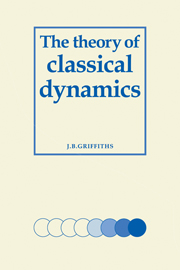Book contents
- Frontmatter
- Contents
- Prefaces
- Introduction
- 1 The Newtonian method
- 2 Space, time and vector notation
- 3 Force, mass and the law of motion
- 4 Newtonian relativity
- 5 Newtonian gravitation
- 6 Particle dynamics
- 7 Systems of several particles
- 8 Rigid body dynamics
- 9 Analytical dynamics
- 10 Variational principles
- 11 Hamilton–Jacobi theory
- Appendix list of basic results and definitions
- Suggestions for further reading
- Index
5 - Newtonian gravitation
Published online by Cambridge University Press: 25 October 2011
- Frontmatter
- Contents
- Prefaces
- Introduction
- 1 The Newtonian method
- 2 Space, time and vector notation
- 3 Force, mass and the law of motion
- 4 Newtonian relativity
- 5 Newtonian gravitation
- 6 Particle dynamics
- 7 Systems of several particles
- 8 Rigid body dynamics
- 9 Analytical dynamics
- 10 Variational principles
- 11 Hamilton–Jacobi theory
- Appendix list of basic results and definitions
- Suggestions for further reading
- Index
Summary
The theory of gravitation really starts from a consideration of the motion of bodies near the earth's surface. It is observed that all bodies have a tendency to accelerate vertically downwards unless they are prevented from doing so by impressed forces acting on them. This acceleration is explained in classical dynamics as the effect of a hypothetical gravitational field which exerts a force on any body that is placed in the field. The general theory of gravitation has, however, been deduced largely from a consideration of the motion of heavenly bodies. This is the approach that is followed here.
Kepler's laws
The motion of the planets seems to have fascinated many past civilisations. Over many centuries the wanderings of the planets across the sky have been recorded. However, as far as the subject of this book is concerned it is appropriate to start with the work of Johannes Kepler. Kepler had at his disposal the mass of observations recorded by previous generations. In particular, he had access to the detailed observations of Tycho Brahe. Tycho's work was remarkable in the degree of accuracy to which he attained, though his observations like those of his predecessors were all made with the naked eye. It is interesting to notice that Kepler published his first two laws in 1609, the same year as Galileo developed the telescope.
Kepler's work is significant in that he introduced a new theory relating to planetary motion.
- Type
- Chapter
- Information
- The Theory of Classical Dynamics , pp. 86 - 102Publisher: Cambridge University PressPrint publication year: 1985

